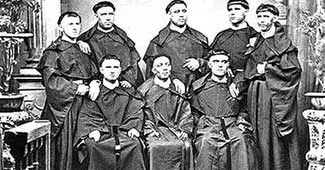The Augustinians and their Role in the Founding of Taal, Batangas, Tanauan, Bauan and Lipa
The Augustinians were the first Catholic religious order to come to the Philippine Islands. In fact, the expedition led by the conquistador Miguel López de Legazpi which sailed out from Nueva España (now Mexico) in 1564 was guided by the navigator Andrés de Urdaneta. De Urdaneta had erstwhile been reluctant to join the expedition, having considered himself retired after joining the Order of St. Augustine in Mexico. Upon receiving a personal letter from Felipe II, King of Spain, asking him to guide the expedition, he felt that it was his duty to obey. He was joined by four other Augustinian missionaries: Martin de Rada, Diego de Herrera, Pedro Gamboa and Andres de Aguirre1. They all helped de Legazpi build the first Spanish colony in Cebu upon their arrival in 1565.
By 1570, de Legazpi ordered an expedition to the island of Luzon, specifically the kingdom by Manila Bay of which he had heard so much of. The expedition was led by Master-of-Camp (the equivalent of Colonel) Martin de Goite (or Goiti as the name was spelled in other Spanish documents) and de Legaspi’s grandson Captain Juan de Salcedo. Before getting to Manila Bay, the expedition first stopped off at the village of Balayan and even explored “the mouth of a river which led inland to a lake, called Bombon2.”
From the time de Legazpi first arrived in Cebu in 1565 to the time when he ordered the exploration of Luzon, more Augustinian missionaries had crossed the Pacific from Nueva Expaña to the islands. The spread of the Catholic faith, after all, was among the principal reasons why the Spaniards had ventured so far away from home.
By May of 1572, with so many Augustinian missionaries having arrived in the country, they felt that the time had come to hold a general assembly and elect a provincial. De Rada, who was among the first of the order to arrive in the islands, was elected spiritual head3.
Apart from the election of a provincial, many other concerns were discussed by the Augustinians during the assembly. Among these was the absence of and the need to build “fixed convents.” In the context of the era, a convent was a community with a church and house where members of a religious order could stay and from where they could spread the word of God4.
“A convent was established in the town of Taal. There is a lake there, generally known as the lake of Bongbong6. Its water is salt, and so deep that the bottom cannot be reached in some parts. It is about forty leguas in circumference (a legua or league roughly being 3 miles7), counting in its gulfs and bays. Shad are caught there, or rather tunny fish (tuna), which, although not like those of España, still approximate to them. The lake empties through a river to a sea. When the Spanish went there, this lake swarmed with people. It is twelve or thirteen leguas from Manila. Its chief town was Taal, where the religious were established.”
At the time, the “lake” was really more an inlet connected to Balayan Bay by a wide channel which could be navigated by ocean-going vessels of the era. Hence, its waters were saline, which explains why not only tuna but even bull sharks once swam in it. The prolonged 1754 eruption of Taal Volcano would hurl enough volcanic debris into the atmosphere to eventually seal off the channel. This, over time, would make the lake’s environment freshwater.
One of the missionaries at Taal in 1572 was Fr. Agustin de Alburquerque, born in 1529 in Badajoz in the Extramadura area of Spain8. The conditions in Taal when the convent was established was far from ideal. De Medina wrote,
“This lake has its islets, especially one opposite Taal, which had a volcano, which generally emitted flames. That made the ministry unhealthful; for the wind or brisa blew the heat and flames into the village so that all that land became parched, and the natives had no lands to cultivate.”
“…as yet no more fire or smoke has been seen, and that island, about four leguas in circuit, has fields and cows, and the inhabitants of Taal sow and reap their harvests in their land.”
From that first convent in Taal, the Augustinians would build more: Batangas (1580), Tanauan (1584), Sala (1586), Lipa (1605) and Baoang (Bauan, 1641)9. The convents in Tanauan, Lipa and Baoang were humble; only houses for missionaries to live in were built. In Batangas, a house and a stone church were built.”
Initially, the building of additional convents in other locations was probably looked at with suspicion by the natives, who stayed away. De Medina wrote, almost with a tinge of humor,
“But they have few people, so that the presence of the Spaniard must be a poison that finishes them. And this reduces them more than their wars or slaveries did in their heathenism.”
2 “The Philippine Islands, Volume III 1569-1576,” compiled and edited by Emma Helen Blair and James Alexander Roberson, published 1903.
3 Along with other details of this article, from “History of the Augustinian Order in the Philippine Islands,” by Fray Juan de Medina OSA written 1630 published 1893. From the Blair and Robertson series “The Philippine Islands Volume XXIV 1625 -1629.”
4 “Convent,” Wikipedia.
5 In the present day, there is a barangay called Balangon in Agoncillo, Batangas. “Agoncillo, Batangas,” Wikipedia.
6 Spanish documents referred to the lake as Bonbon, Bombon and Bongbong.
7 “League,” Wikipedia.
8 “Alburquerque, Agustin de,” online at Iglesia Evangelica Pueblo Nuevo.
9 “Memoria acerca de las Misiones de los PP. Agustinos Calzados en las Islas Filipinas: presentada al Excmo. Sr. Ministro de Ultramar,” Madrid 1892.

